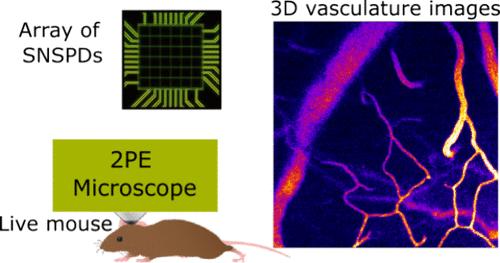Deep Mouse Brain Two-Photon Near-Infrared Fluorescence Imaging Using a Superconducting Nanowire Single-Photon Detector Array
IF 6.5
1区 物理与天体物理
Q1 MATERIALS SCIENCE, MULTIDISCIPLINARY
引用次数: 0
Abstract
Two-photon microscopy (2PM) has become an important tool in biology to study the structure and function of intact tissues in vivo. However, adult mammalian tissues such as the mouse brain are highly scattering, thereby putting fundamental limits on the achievable imaging depth, which typically reside at around 600–800 μm. In principle, shifting both the excitation as well as (fluorescence) emission light to the shortwave near-infrared (SWIR, 1000–1700 nm) region promises substantially deeper imaging in 2PM, yet this shift has proven challenging in the past due to the limited availability of detectors and probes in this wavelength region. To overcome these limitations and fully capitalize on the SWIR region, in this work, we introduce a novel array of superconducting nanowire single-photon detectors (SNSPDs) and associated custom detection electronics for use in near-infrared 2PM. The SNSPD array exhibits high efficiency and dynamic range as well as low dark-count rates over a wide wavelength range. Additionally, the electronics and software permit a seamless integration into typical 2PM systems. Together with an organic fluorescent dye emitting at 1105 nm, we report imaging depth of >1.1 mm in the in vivo mouse brain, limited mostly by available labeling density and laser properties. Our work establishes a promising, and ultimately scalable, new detector technology for SWIR 2PM that facilitates deep tissue biological imaging.

利用超导纳米线单光子探测器阵列进行小鼠大脑深部双光子近红外荧光成像
双光子显微镜(2PM)已成为生物学中研究体内完整组织结构和功能的重要工具。然而,成年哺乳动物组织(如小鼠大脑)具有高度散射性,因此对可实现的成像深度造成了基本限制,通常在 600-800 μm 左右。从原理上讲,将激发光和(荧光)发射光转移到短波近红外(SWIR,1000-1700 nm)区域可大幅提高 2PM 的成像深度,但由于该波长区域的探测器和探针有限,这种转移在过去已被证明具有挑战性。为了克服这些限制并充分利用 SWIR 区域,我们在这项工作中引入了一种新型超导纳米线单光子探测器 (SNSPD) 阵列和相关的定制检测电子设备,用于近红外 2PM 中。SNSPD 阵列在很宽的波长范围内表现出很高的效率和动态范围,以及很低的暗计数率。此外,电子元件和软件可无缝集成到典型的 2PM 系统中。我们报告称,结合一种在 1105 纳米波长处发光的有机荧光染料,在体内小鼠大脑中的成像深度可达 1.1 毫米,这主要受到可用标记密度和激光特性的限制。我们的工作为促进深部组织生物成像的 SWIR 2PM 确立了一种前景广阔、最终可扩展的新型探测器技术。
本文章由计算机程序翻译,如有差异,请以英文原文为准。
求助全文
约1分钟内获得全文
求助全文
来源期刊

ACS Photonics
NANOSCIENCE & NANOTECHNOLOGY-MATERIALS SCIENCE, MULTIDISCIPLINARY
CiteScore
11.90
自引率
5.70%
发文量
438
审稿时长
2.3 months
期刊介绍:
Published as soon as accepted and summarized in monthly issues, ACS Photonics will publish Research Articles, Letters, Perspectives, and Reviews, to encompass the full scope of published research in this field.
 求助内容:
求助内容: 应助结果提醒方式:
应助结果提醒方式:


